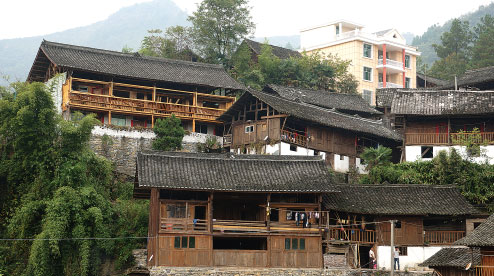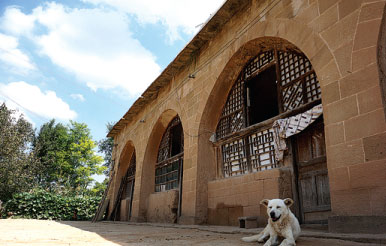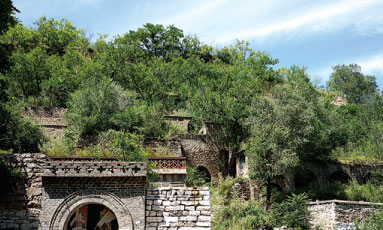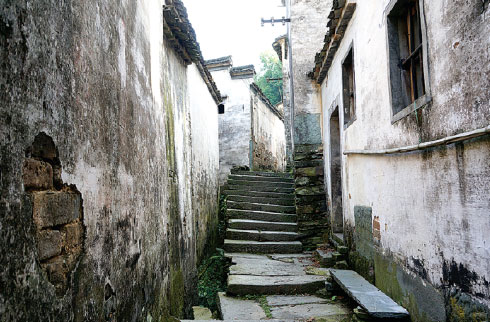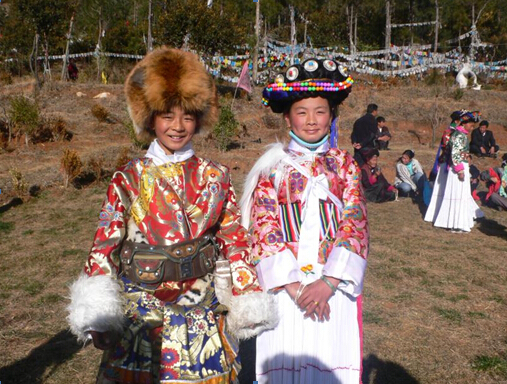Preserving the past to safeguard the future
(China Daily)
Local authorities and concerned citizens are at the forefront of moves to ensure the survival and profitability of China's ancient villages, as Xu Jingxi reports.
West of the grand, modern Fuzhou South Railway Station in Fuzhou, the capital of Fujian province, stands a heap of rubble that was once Lulei, a village famous as the birthplace of several major figures in Chinese history, including the mathematician Chen Jingrun (1933-1996), a renowned expert on number theory, and the Kuomintang admiral Chen Shaokuan (1889-1969).
Despite its 700 years of history, the village was razed to make room for the new rail station. The great mathematician's former home isn't immediately identifiable amid the rubble, but at least the admiral's house managed to survive, even if it does sit in the shadow of an overpass.
The only other building still standing is the village's ancestral hall, where residents traditionally gathered to make rules and regulations, and descendants worshipped their ancestors when they visited from overseas.
The hall only narrowly escaped the bulldozers after Lulei residents and their descendants ouside of China rallied round to protect what they called "the anchor of their memories".
Business tycoon Chen Yu was moved when he stopped by the now-closed ancestral hall in May. "It epitomizes local architectural techniques, and is a focus of people's emotions about the village. It's the soul of the village. Tearing down the ancestral hall would mean cutting off the roots of the village's descendants."
Chen, who hails from Zurong, a village within the boundaries of Lulei, was moved by a red banner he saw on the hall's closed gates that read: "For the interests of the whole, our village can relocate. However, history cannot be rebuilt (if the ancestral hall is pulled down)."
The sight prompted the 45-year-old founder and president of Guangdong Modocom Food Group to begin a seven-month journey across China that took him and his team to 91 ancient villages, where they assessed the chances of survival amid the country's rapid urbanization, and raised public awareness of the issue.
Chen sponsored and led the 13-strong team on the voyage of discovery. Starting out on May 6, the team left footprints all over China as it traveled east to Dandong in Liaoning province, west to Hami in the Xinjiang Uygur autonomous region, south to Sanya in the island province of Hainan, and north to Mohe in Heilongjiang province.
The team members were surprised by the modern industrial prosperity of some ancient villages - such as Beiwan in Guangdong province, a 515-year-old former hamlet that's become a manufacturing base for toys and woollen goods - that are rapidly being transformed into small towns.
The team also visited villages that are steeped in traditional arts and boast beautiful old buildings, but have been deserted by young people. In one, Yanwo in Anhui province, it found the exquisite Hui-style buildings, one of the major architectural styles of ancient China, now house just a few dozen seniors and two children. The rest of the younger generation was nowhere to be seen.
Disappearing villages
Villages have been disappearing at an alarming rate, with nearly 300 - many of them ancient - dying every day from 2000-2010, according to Feng Jicai, vice-chairman of the China Federation of Literary and Art Circles and an advocate of the protection of ancient villages.
"The rapid urbanization and the fast building of the 'new socialist countryside' are the main reasons behind the extinction of ancient villages. Development is necessary, but rural culture is being discarded, largely because we didn't have enough time to prepare for the changes," Feng told the Web portal Sohu in an interview.
"There are now an alarming number of empty or even dead villages, because the young people have left to work in cities and towns, leaving the elderly in the countryside, or sometimes even taking them to live in cities and towns, too."
Modocom's Chen Yu shared Feng's opinion, saying that sooner or later villages close to large cities, such as Lulei, will be cleared to make way for urban expansion.
However, although he acknowledged the changes as "unchangeable fate", Chen called for a measured and sensitive approach. "The demolition shouldn't be oversimplified and crude. The government can give the village a 'health check' beforehand to find out if there are any important historic relics," he said.
"We are unable to preserve the whole of Lulei village, but we can preserve its three most important buildings - the ancestral hall, and the homes of Chen Jingrun and Chen Shaokuan," he added. "If these three old buildings were well protected near the modern railway station, Fuzhou natives would be able to show them to foreign visitors and proudly say, 'We have developed, but at the same time we have respected our history'."
In December 2013, the Ministry of Housing and Urban-Rural Development started the first national census of traditional buildings in an attempt to protect the nation's non-renewable cultural heritage. The nine-month survey identified as many as 15,000 traditional dwellings in 31 provinces, autonomous regions and municipalities.
"Traditional Chinese culture is maintained in traditional dwellings. However, few farmers we met during the journey realized the beauty and value of their old houses," said Sun Jinlong, 57, an artist who traveled as a member of Chen Yu's team.
In Yanwo, Sun was pained to visit a Hui-style house and discover exquisite wooden beams bearing carvings explaining the basis of Confucian morality had been poorly maintained. Moreover, a number of similar carvings had been stolen, probably by antique dealers, even though the owner was puzzled as to why the thieves wanted "the pieces of wood".
"It's the government's duty to make farmers aware of the beauty and value of their traditional dwellings. It's an urgent task," Sun said.
Cultural confidence
In many villages it's common to see boxy, three-story brick houses with strip tiles on the external walls, no matter how out of place they look among the surrounding traditional architecture.
"It's become a 'golden criterion' of success in rural areas for farmers to replace their old houses with new ones, using the money they've earned in cities," said Liu Fanggang, who also participated in Chen Yu's survey.
"During the journey, I was disappointed to discover that it's usually the farmers who do the worst damage to ancient villages, their hometowns," the 61-year-old architectural designer said.
"There's still a long way to go on the road to rebuilding confidence in farming culture. We shouldn't allow it to be ruthlessly run over by the bulldozer called 'economic development'."
Chen Yu said all new buildings should be in harmony with tradition, and called on the government to issue instructions about the types of houses villagers are allowed to build to replace their old ones "before it's too late".
However, he was more positive about the renaissance in farming culture and traditional arts in China. "People's need for culture will grow as the economy develops. There's a growing market for tours to ancient towns and villages. City dwellers want to experience the tranquility of the countryside, and appreciate architecture and traditional culture and arts that display local characteristics," he said, adding that the popular tourist villages of Lijiang in Yunnan province and Hongcun in Anhui are good examples of how that can be achieved.
"I don't think commercial exploitation has a negative effect on the protection of ancient villages because it can show villagers the value of their traditional dwellings, customs and folk arts," he said, pointing out that the traditional dwellings in Yulong village, Yunnan, have been well maintained because the villagers had noticed the commercial success of nearby Lijiang.
"I hope the government will encourage rural land transactions so those businesspeople who sincerely love traditional villages will be able to make good use of the resources," he said.
According to Zhao Hui, head of village affairs at the Ministry of Housing and Urban-Rural Development, the government encourages reasonable exploitation and development of traditional villages, but has also imposed strict controls to prevent over-exploitation.
At an October media briefing about the protection of traditional villages, Zhao said: "Over-exploitation is the major problem, so control is still the theme. We don't allow developers to change a residential area into a shopping street, nor will we allow them to move local residents out and turn their villages into 'museums'."
Contact the writer at xujingxi@chinadaily.com.cn
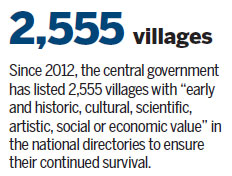
|
Xifan village in Kaili, Guizhou province. |
|
Weita village in Yan'an, Shaanxi province. |
|
Yinjiao village in Taiyuan, Shanxi province. |
|
Yanwo village in Huangshan, Anhui province. All Photos Provided to China Daily |
(China Daily 02/09/2015 page6)

